
This year I had not planned to take part in any race during the Summer cycling trip. This and the fact that I had planned to leave for the Alps later this Summer both turned out to be very lucky for me. I had just managed to get back on the bicycle again after an accident (broken collarbone/clavicle, head concussion, etc.) five weeks prior to leaving for the Alps tour.
I had, however, planned to take part in the Ötztaler Radmarathon four weeks after the Alps tour. This is a famous marathon race that I still had not participated in prior to this and it is usually somewhat difficult to get a starting place in that race which is limited to 4000 participants (I believe it was only 2500 some years ago), but me and my friend Ola were lucky to be accepted, so we decided to get down there for the ride.
The Ötztaler Radmarathon is one of the hardest one-day amateur marathon competitions (Gran Fondo) in the world, being somewhat similar in scope to the La Marmotte marathon in France, but there are now several similar races. The organizers claim that the race is 238 km and 5500 height metres, but my computer suggested it was merely something like 220 km and 5200 height metres. I think both that my computer is rather “conservative” in its measurements and that the organizers probably has rounded things off upwards a bit, but I do not know for sure. Anyway it is a long and hilly ride.
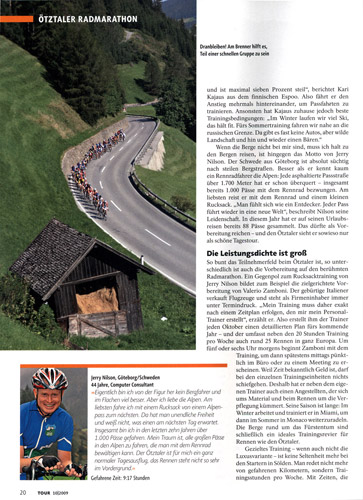
We arrived in Sölden late on the Friday, August 28th and the race was on Sunday the 30th, so we had time to get out on Saturday for a little ride. Unfortunately the weather was not too nice this day, so we waited until after lunch time to get out cycling. We were up decently early as I had proposed to meet up for an interview after breakfast with a reporter from the German bicycle magazine Tour.
The interview was a nice 30 minutes chat with the enthusiastic Kristian of Tour and I learned that he not only wrote about these events, but indeed also took part (not sure if he did this race though, but maybe). We had some photos in the gray and cold morning weather and they published a little write-up on this in the next issue of the magazine (click on the scanned page here to see a bigger, readable image). The angle of the article was to do short presentations of riders coming from afar to take part in the Ötztaler and to hear what brought them here. This is a race that has a bit of a cult status and many cyclists wants to have done this at least once in their life. (Professional cyclists might not be as eager.)
We walked around a little in Sölden and had a little lunch at a bakery. There were lots of nice cycling goods for sale in shops that otherwise mainly sell ski equipment. Go to see some nice Lightweight wheels for example (incredibly light wheels that feels like they were made of papier-mâché). We also noticed the tube machine on the wall outside one of the shops in the photo below.
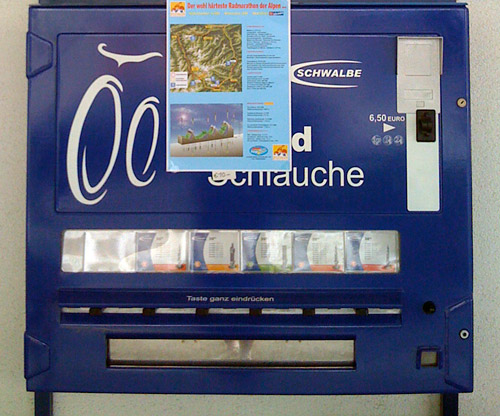
We was not out of Sölden until 14 pm, I think, but we only thought about a 4 hours ride anyway. I had first had the idea of visiting the Pillerhöhe (1559m), which is a steep climb in the vicinity. We decided to first go down to the end of the Ötztal valley and see what the weather would be like and when down at the big Inn valley, the weather looked a bit dubious in the direction of Pillerhöhe, and if we wanted to make sure to get there and back in time, we would have had to climb it from the third easy side, which would not be so fun anyway. Luckily, I was aware of a nearby alternative climb up to Sattele (1690m) from Haiming (678m), which is a pretty steep 1000m climb at an average of just above 10% for 10 km.
Actually I had thought I had climbed all asphalted passes above 1681m before coming here, but I had missed to take this pass into account as the Austrian pass catalogue by the Club des Cent Cols does not list this pass as asphalted (the catalogue is unreliable in other places too, but it is built upon work done a long time ago, as I understand it). I also have read about this pass as being asphalted before anyway, but had forgotten it. So this was good to be able to add to my list and it is in fact a quite nice climb from this side, with fine views across the Inn valley. This pass is mostly an alternative to get to the Kühtai(sattel) pass from Oetz.
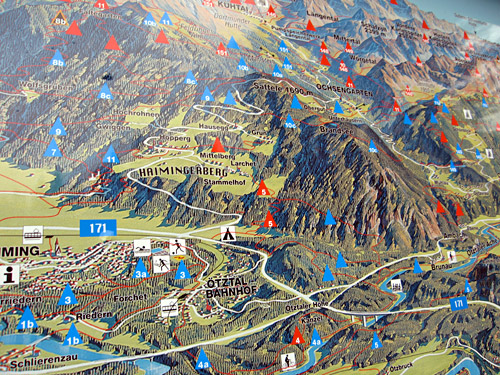
When we got up to the pass we some cyclists, but none on the way up our side. We continued down to Ochsengarten on the other side, after I took a photo of the area information sign there. I had seen on a local map that maybe we could bypass Oetz on the way back to Sölden a little by taking a small road just above Taxegg and I even asked some locals there who suggested it was possible. After a while we soon came to the end of the road. The continuing path/dirt road first seemed fine, but soon turns to a difficult path, so we returned back the same way. The first photo above was taken on this road, with nice views up the Ötztal.
We had a pizza and went to bed somewhat early to be ready for the early breakfast and start.
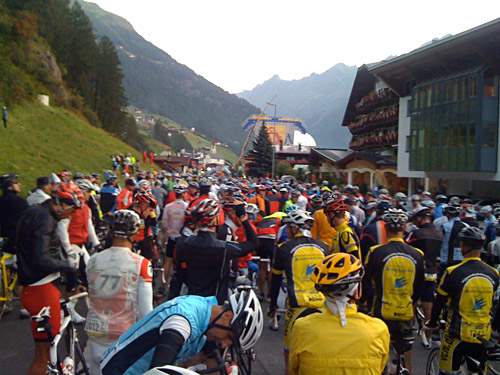
I am never eager to get up early for races and dragged out on time eating breakfast until we had to get going. Since I had no ambition to hang on the better riders in the race, I did not care too much about if I had to start a bit behind the first riders. Now we found out that there were actually an alternative road through Sölden, which we had wondered about the day before and after some time we managed to get in on the main road where the start field was lined up.
I knew there would be a group of invited (?) riders with ambitions to try and get in with the best at the front and they would start separately from the rest of the participants. So I would anyway not have a real chance to try and hang on to the best guys from start. Down to Oetz that might have been possible for me (if I had dared to go really fast through some of the serpentines down there), but being realistic I know I would just see them slowly disappear in front of me up the Kühtai no matter what I had done (short of stopping them), so the fun would be over quickly. The best riders in races of this sort could do well in any professional long mountain stage race and some have also been doing just that. This is part of the fun with Gran Fondos, that there will be always be enough competition no matter how good you are (or how bad for that matter, when the competition may be to simply get to the finish line before they put you on a bus back).
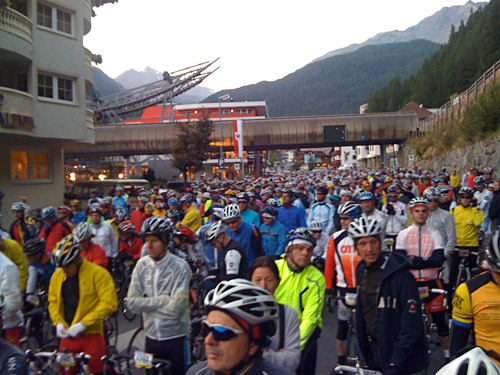
I walked up on the side a little to not be at the absolute end of the start field, but I recently received a video of the event and managed to spot myself at the start, which showed that I had most of the riders in front of me of the close to 4000 starters.
The start went well and as I wanted to get warm and try to pass by as many not so good riders as possible before reaching Oetz and the start of the climb up the Kühtai (2017m), I went in a high speed down there. I continued in good speed up all the way to the Kühtai pass as I felt fine. There were one short gravel section with road road work on the absolutely steepest part of the race (17-18%), but we cycled up here sitting down (later on they had walked up this section I heard from my friend). Apparently I was up as number 265 in my age group, but only finished as number 446, so clearly I started out a bit too optimistic (or rather could not hold on to this speed later on).
I nearly passed by no one on the descents as I was very keen on not having any accidents. What is the point of taking chances when you are not in the front group? I guess I passed by two people or so on all descents combined. Despite having descending more Alps passes than most and should know how to get down speedily, I still feel it is very dangerous and every pass is very individual and curves can be handled in a myriad of ways (nuances). Maybe I even become slower and more careful over the years as I know what dangers are involved and it is also part of my way of travelling in the Alps where I cannot rely on having any support for damaged wheels – I need to be able to get on. Also the time lost on the descents is something I usually quickly can gain back on the other riders as I am usually quicker than the riders around me on the flat stretches.
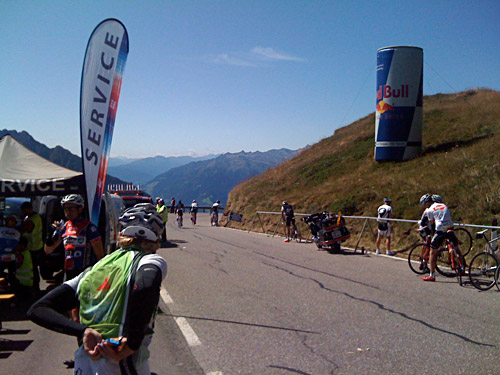
The descent from Kühtai is one of the quickest in all of the Alps – it might well be the one where one could get the highest speed of everywhere, but there are contenders and it depends on what chances one is willing to take and ones technique, of course. I was stopped a bit by other riders on the fastest part, so never bothered to have a look on the computer. I had hoped to beat my old record down here easily when I in rain went down here at 91 km/h. It should be easy to get above 100 km/h down here. I guess I was up at around 85 km/h this time and probably I went as fast or faster down the first stretch of the Timmelsjoch were I passed by a guy in at least 20 km/h faster than him.
I got help with two other guys to catch up with a big group just before we reached Innsbruck. This was fortunate as I got good help hanging on to this group up the Brennerpass (1370m) (the only new pass for me in this race, as I have only gone over it with train before). The Brennerpass turned out to be quite nice and nicer than I had anticipated. We held an average speed at around 30 km/h, so pretty good even if it was not really steep anywhere. All looked fine and when the big group split up to two groups I moved ahead and joined the first group. But all the ambitiousness and hard going before suddenly made itself known to me when I really “hit the wall” just as we started on the last little stretch that is a bit steep up to the pass. I fell behind without being able to do anything but to take it easy. I had to stop at the Brennerpass and take my time to get as much to drink and eat as I could before continuing down.
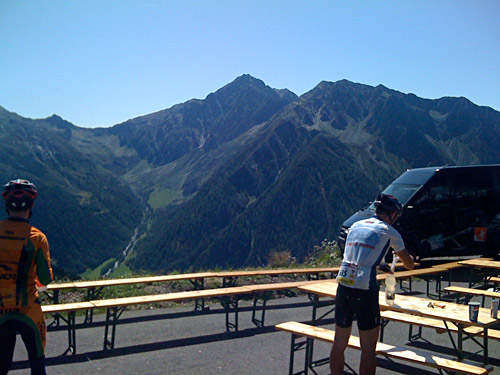
So I lost 10 minutes or so here on the group I had followed up to the pass. On the way down the Brennerpass, people still went faster than me, but the descent was a bit relaxing and I could hope the Pepsi and bananas worked into my body to prepare me for the Jaufenpass/Passo di Monte Giovo/Passo del Giovo (2099m), which I have always thought is an easy Alps pass. As I had been drinking quite a lot I had to stay early on to let some of it out. Then I was able to go up in a decent speed again and overtook many riders that had passed me by on the way from the Brennerpass. Near the top I was again starting to run out of energy and had to slow down a bit at the last stretch to not totally hit the wall again.
Again I filled up, drinking a lot and to prepare myself for the obvious heat waiting down at the start of the climb up to the Timmelsjoch. I decided to take things easy and focus on just having fun. The weather was perfect and I took some photos here before descending the horribly bad road. The organizers had thankfully warned beforehand of the many, long, deep and wide cracks in the asphalt down here. I remember having descended here two times before and remembered how good I had thought the surface was back then. I have never been going down as slowly on the road as this time and sure enough there were at least one ambulance picking up a guy on the roadside down here. I was only a millimetre away from going into one of these cracks myself at one point. An added difficulty was the partial shade from trees which made it very difficult to see the cracks in time. Still other cyclists descended as if there were no tomorrow, just as usual. No idea why as I passed them all by quickly later on.
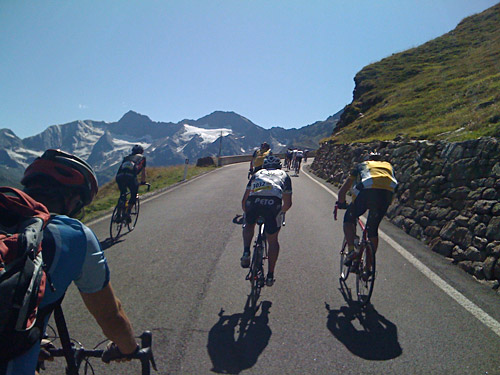
At the start of the climb up the Timmelsjoch/Passo di Rombo (2474m) it was now hot Summer temperatures in the sun. I started out in a good speed and was soon joined by another younger cyclist who also thought all others were going much too slow. But at the start of the steep serpentines up from Moos, I had to say goodbye to this guy as I realised I might soon hit the wall again. I met him later at a café on the town and he finished 16 minutes faster than me (and wondered if I would put up a webpage about this – hope he will find it!). I deliberately went up a little slower than I could, but still the climb turned out to be really hard. I remembered this section as very hard, but it was longer and harder than I had remembered (this is actually the worst part of the climb up this gigantic pass).
I was just on the verge of hitting the wall again – I think had but did not realise this was so until after I had stopped at the first station up here after this part of the climb. The climb up to the Timmelsjoch is almost flat for four kilometres half-way up. There were two stations to stop at: one was 1-2 kilometres in on the flat section and I stopped here to prepare myself for the final climb up the pass. After leaving the feeding station I noticed as fast as the road started to climb a little that I had no real power left to be able to go in my usual speed and I decided to stay at the second smaller feeding station too to drink still some more Pepsi. It did not help much as the steepest part up the pass starts here and there are no more places to recuperate along the way to the pass.

I decided to just go on despite this and keep whatever speed I could, just forcing myself up there. I was disappointed to see other people overtake me every now and then; people who would normally not have a chance on hanging on to me. People took photos and chatting with each others as I fighted on to make sure I reached the pass without any stopping. I doubted I would gain any time on trying to wait a little and then go at a higher speed up, but my calculations might have been wrong. I just took it easy and tried to forget about the others and looking at the nice scenery up here. This pass (from this side) is really the high point of the race and it is quite lovely going up these serpentines (even if being out of energy).

Eventually I reached the dark tunnel at the top and could relax. There are still two kilometres to the pass height, but this stretch is almost flat again and with new nice scenery. When I reached the pass I turned around before crossing the red time-taking carpet and two-three people staying there cheering people on wondered what I was doing – “go, go, go” they said. I said the climb was so nice I must go down and do it again! But soon they realised I was just stopping by the pass sign to have a photo. Then I asked them to take a photo of me, which they happily did. I thanked them and went over the red carpet having lost over 100 places on this climb. Have to do it again with better preparations and maybe I could go under 9 hours, which I think should be quite possible for me.
On the way down to Sölden there is first a little rise after the long initial speedy descent. Here I catched up with a couple of riders that passed over the carpet while I had the photo session at the pass. Then I hanged on to two guys in quaeldich.de jerseys and decided I should give them a hard time down to Sölden.
Now I was suddenly back in good shape again and felt like no one could possibly overtake me and surely no one did down to Sölden. After a while with the guys on my wheel, I noticed they had let me go ahead. I went down full speed to Sölden and looked around a little as I passed through the main street in Sölden, but could not see anyone behind me so went relaxed over the finish line on 9h17mins.
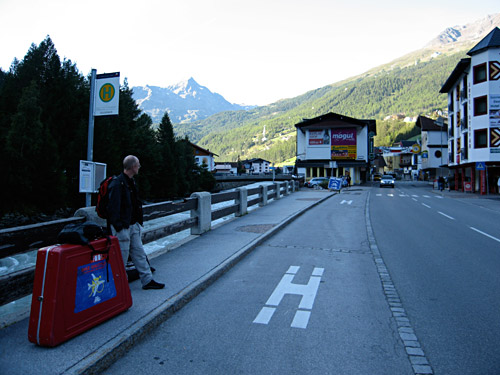
I went back to the hotel and took a shower and a little nap, then I went out on town and then I had a phone call from my friend Ola who had just finished a little over an hour later than me. Last photo is from us waiting for the local bus the next day in Sölden down to the Ötzal train station in Haiming.